Note: original on tank encyclopedia.
The T-34/85 is a Soviet medium tank that was developed and widely used during World War II and in the years following the war. It was an improved version of the earlier T-34 tank, which had been one of the most successful and influential tank designs of the war. The "T-34" in the name refers to the tank's model, while the "85" denotes the tank's main armament: an 85mm gun. The T-34/85 was introduced in 1944 and featured a larger turret with a more powerful 85mm D-5T gun compared to the earlier 76.2mm gun on the standard T-34.
This larger gun allowed the T-34/85 to engage enemy tanks more effectively. The T-34/85 was known for its simplicity, reliability, and the ability to be produced in large numbers. It had sloped armor that offered good protection, and it was relatively fast and agile for its time. These characteristics made it a formidable tank on the Eastern Front of World War II and in various post-war conflicts. The T-34/85 continued to serve in many armed forces well into the Cold War era, and it played a significant role in conflicts around the world. It remains an iconic symbol of Soviet tank design and World War II history.
The T-34/85 was an evolutionary development of the famous Soviet T-34 medium tank, designed during the Second World War to address the growing threat of new German armored vehicles such as the Panther (PzKpfw V) and Tiger (PzKpfw VI). By 1942–1943, the original T-34/76 with its 76.2 mm gun was no longer sufficient. German tanks were receiving heavier armor and more powerful guns (75 mm KwK 42 on the Panther, 88 mm KwK 36 on the Tiger). Soviet reports from the Battle of Kursk (July 1943) confirmed that the T-34/76 struggled to penetrate these new tanks at normal combat ranges. The Red Army urgently needed an up-gunned and up-armored version of the T-34 that could be fielded in large numbers without disrupting production.
The Soviet design bureaus considered both new tank projects and an upgrade of the T-34. A completely new medium tank, the T-43, was in development but proved too heavy and slow for mass production. The solution was to adapt the T-34 chassis with a larger gun and stronger armor. Key design changes were the new and larger, three-man cast turret with a commander’s cupola (a big improvement over the cramped two-man turret of the T-34/76). The front hull armor increased to 75 mm sloped plate; turret armor up to 75–90 mm. The Main gun was of course the new 85 mm ZiS-S-53 gun (initially prototypes tested the 85 mm D-5T), capable of defeating German armor at typical battle ranges.
Several experimental designs were tested in late 1943: A T-34 mounting the 85 mm D-5T gun. Modified turrets and mantlets tested for effectiveness. After evaluation, the ZiS-S-53 gun was selected for mass production due to better reliability and ease of manufacture. It was officially adopted in January 1944 as the T-34/85. Mass production began in factories such as Factory No. 112 “Krasnoye Sormovo” and Factory No. 183 Ural Tank Plant. Production was kept as streamlined as possible to maintain the Soviet war industry’s output (the Soviets prioritized quantity as well as quality). Between 1944 and 1945, more than 22,000 T-34/85s were built.
It Entered combat in early 1944, first appearing in significant numbers during the Battle of the Dnieper and later in the Soviet offensives of 1944–45. Restored the balance against German Panthers and Tigers, though the T-34/85 was still not invincible. Its 85 mm gun could penetrate a Panther’s side armor and a Tiger’s frontal armor at closer ranges. Remained the backbone of Soviet armored forces through the final offensives into Eastern Europe and Berlin.
The T-34/85 was not an all-new tank, but a deep modernization of the T-34/76. Its design balanced firepower, protection, mobility, and mass producibility, with a focus on simplicity and ruggedness.
Main Gun: 85 mm ZiS-S-53 (final production gun, from 1944). Barrel length: L/54.6 (4.65 m). Muzzle velocity: 792 m/s with AP rounds. Penetration: ~100 mm at 500 m (could defeat Panther side armor, Tiger front armor at closer range). Elevation/Depression: +22° / –5°. Ammunition carried: 55–60 rounds (mix of AP, HE, and sub-caliber).
Secondary Armament: 2 x 7.62 mm DT machine guns: Coaxial with main gun. Hull-mounted in ball mount. Ammunition: ~1,890 rounds.
Optics: TSh-15 telescopic gun sight. Periscopes for all crew positions.
Radio: 9-RS or 10-RK radio set. Unlike early T-34s (where radios were rare), the T-34/85 was universally equipped — crucial for command and coordination.
Other Equipment: Standard Soviet external fuel drums (non-integrated, jettisonable). Onboard tool kits and spare track links mounted on hull.
Factories made small variations:
Factory No. 112 ("Krasnoye Sormovo"): cast turrets with prominent “cheek” bulges.
Factory No. 183 (Ural Tank Plant): more streamlined cast turrets.
Welded turrets were used when casting capacity was limited.
Simplification for mass production: Minimal machining. Standardized parts across production batches.Dimensions (L-W-H) 8.15 (5.12 without gun) x 3 x 2.6 m
26’9″ (16’10” without gun) x 9’10” x 8’6″ Track width 51 cm (1’8″ ft.inch) Total weight, battle ready 32 tons Crew 5 Propulsion V12 diesel GAZ, 400 bhp (30 kW) Speed 38 km/h (26 mph) Range (road) 320 km (200 mi) Armament 85 mm (3.35 in) ZiS-S-53
2x DT 7.62 mm (0.3 in) machineguns Armor 30 to 80 mm (1.18-3.15 in) Production (model 1944 only) 17,600 
First Appearance was in early 1944, by entering official service by January 1944, but field tests late 1943. Its First major combat was the Battle of Korsun–Cherkassy Pocket in Ukraine, February 1944. The crews immediately appreciated it stronger gun that could engage German Panthers and Tigers. The better turret design with a commander free from gunnery duties. By spring 1944, whole tank brigades were being re-equipped with it. On the Eastern Front by mid-1944 before Operation Bagration, and until early 1945 the T-34/85 became the mainstay of the Red Army in the final phase of the war.
Against the Panther, its ZiS-S-53 85 mm gun could penetrate the Panther’s side armor at typical ranges (500–1,000 m). Front armor of the Panther (80 mm at 55°) was tough, often requiring flanking attacks or close range. In practice: T-34/85s tried to swarm Panthers, using superior numbers and mobility. Against the Tiger I, its frontal armor (100 mm) could be pierced at ~500–800 m with AP rounds. From the side, it was vulnerable at much longer distances. The T-34/85 was far more mobile than the Tiger, giving it tactical flexibility.
Against the Tiger II (King Tiger), the 85 mm gun struggled badly. Soviet doctrine: use IS-2 heavy tanks and artillery to take them on, while T-34/85s maneuvered around them. The T-34/85 formed the core of Soviet tank corps and mechanized corps from 1944 onward. Operation Bagration (June 1944) saw its first mass-use, helping to destroy German Army Group Centre.
The Vistula–Oder Offensive (January 1945) was a rapid Soviet advance across Poland. It was also widely used in the Battle of Berlin (April–May 1945), spearheading assaults into the city, fighting house-to-house and against German anti-tank weapons. Its main strenght was to have been produced in tens of thousands. It could handle harsh conditions better than German tanks. And in general was an all round "good enough" mix od firepower, armor, mobility balance.
Combat Weaknesses were its vulnerability to German Panzerfausts and Panzerschrecks in close fighting, Inferior optics and fire-control compared to German tanks and main gun less effective against heavy German armor (Tiger II, Jagdpanther).

Postwar Combat Service was intense. It became a Cold War workhorse, soldiering in the Korean War (1950–53) with North Korean T-34/85s initially overwhelming South Korean forces. Once UN forces deployed M26 Pershings and M46 Pattons, the T-34/85 suffered heavy losses. The Chinese also copied it as the Type 58. It wa sorminent still in the Middle East Wars, supplied to Egypt and Syria. It was used in 1948 Arab–Israeli War, 1956 Suez Crisis, and 1967 Six-Day War. By then, badly outclassed by Centurions, M48 Pattons, and Israeli Shermans with 105 mm guns.
North Vietnam used T-34/85s early on, but later replaced them with T-54s. It saw service in Angola, Somalia, Ethiopia, and Yugoslavia’s wars in the 1990s ans still was featured in many conflicts around the globe in militias or reserves. In WW2 it was a war-winner, restoring the Red Army’s ability to fight German armor on more equal terms. Postwar it became one of the most widely used tanks in the world — a symbol of Soviet military aid and influence. Militarily, it also marked the transition between the early war medium tank and the postwar main battle tank (MBT) concept.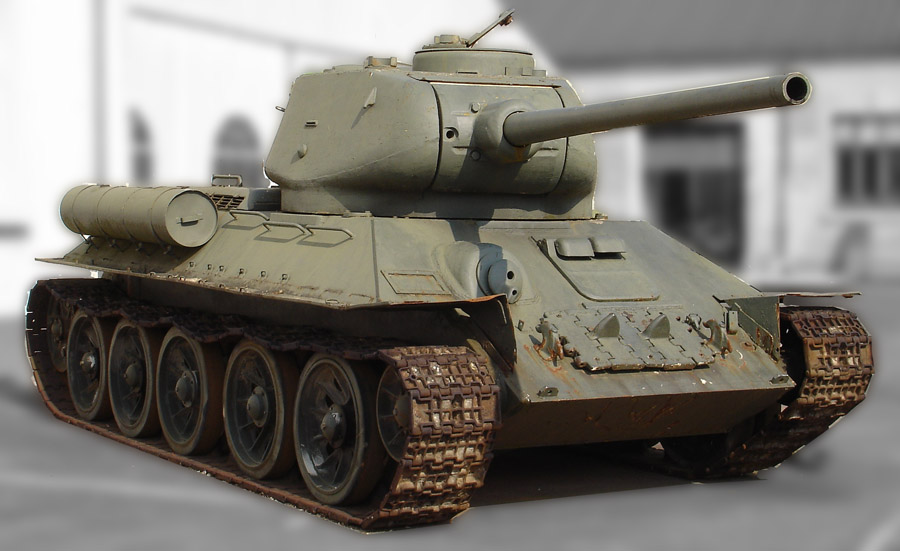
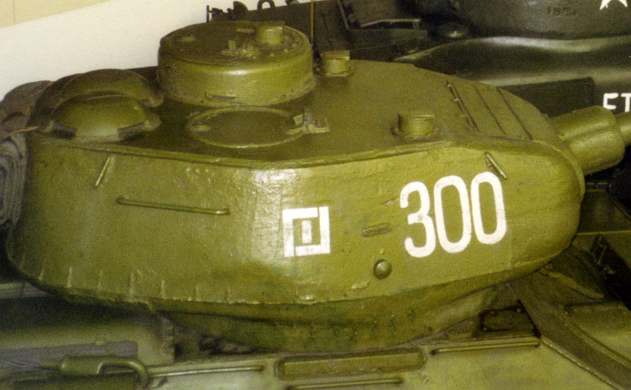
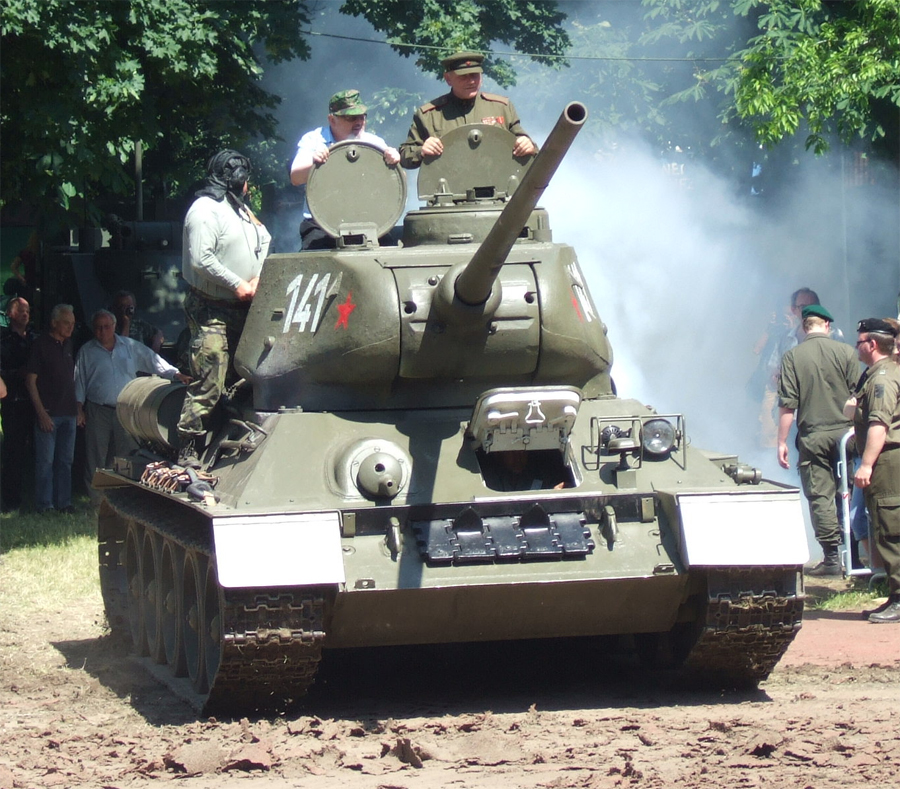
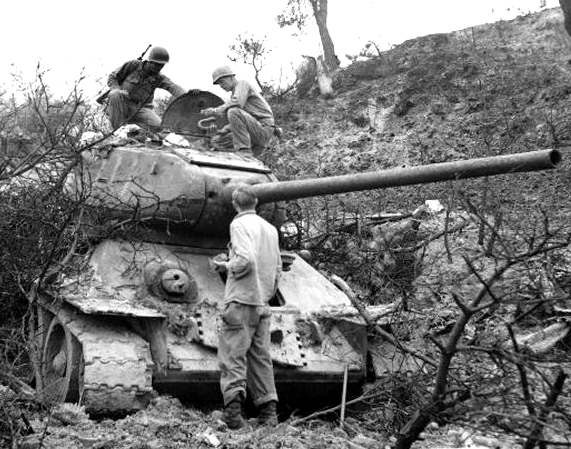
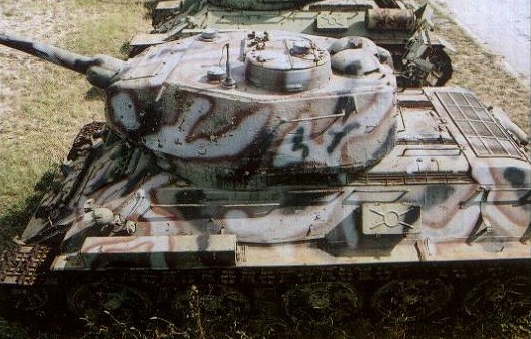
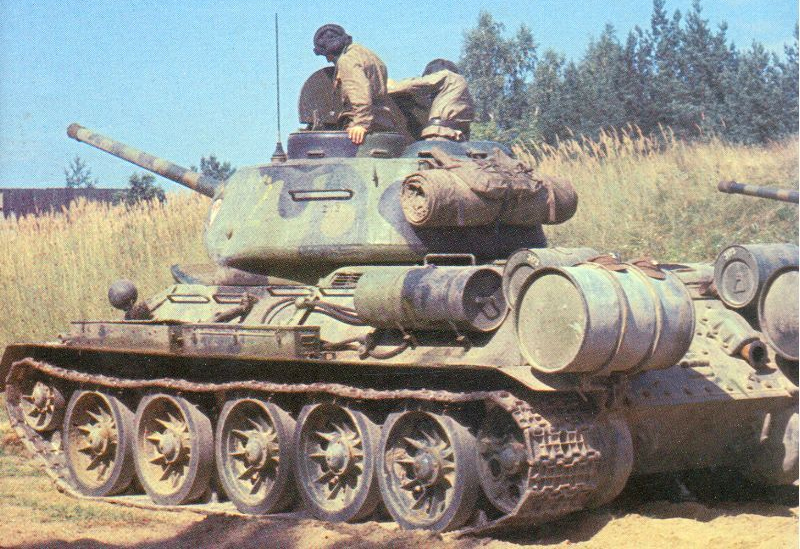
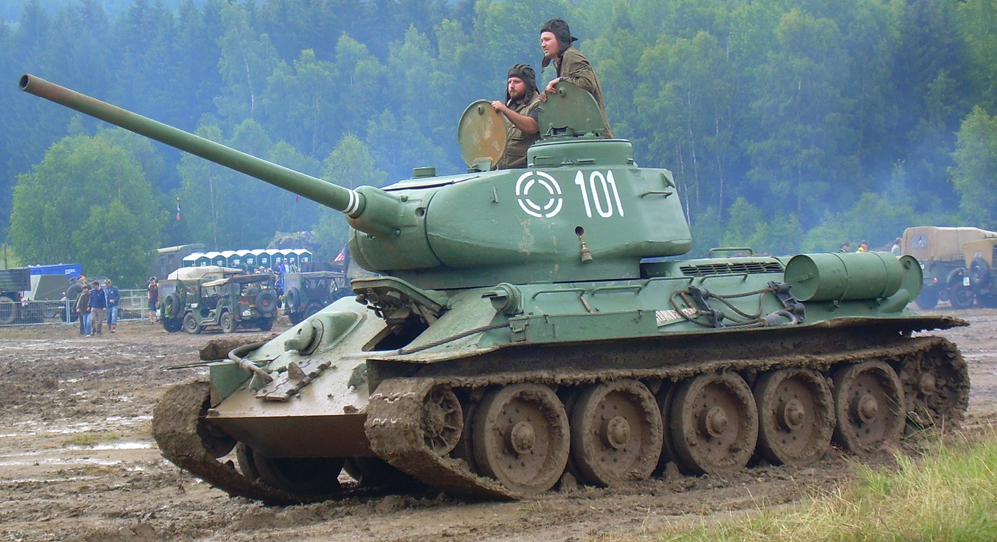
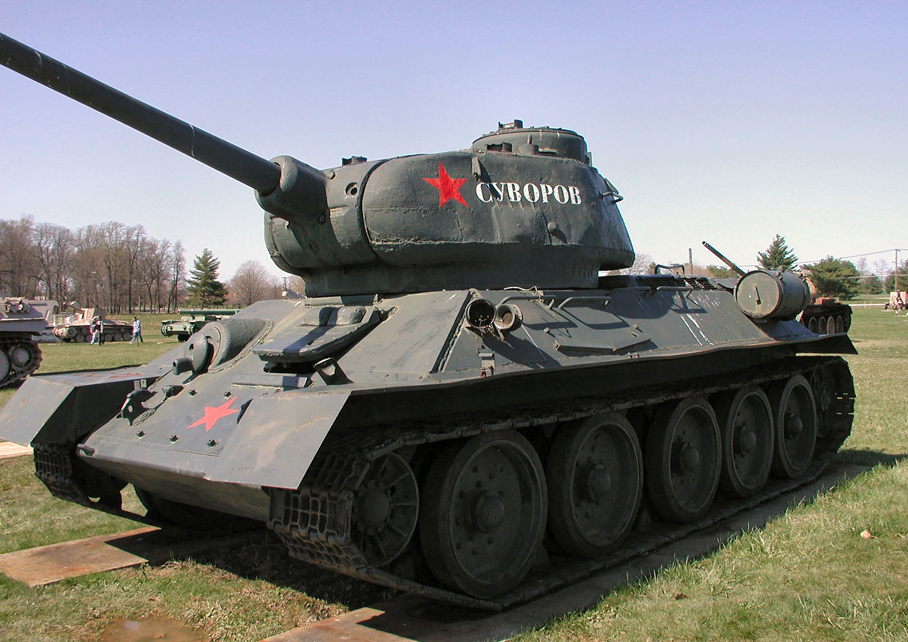
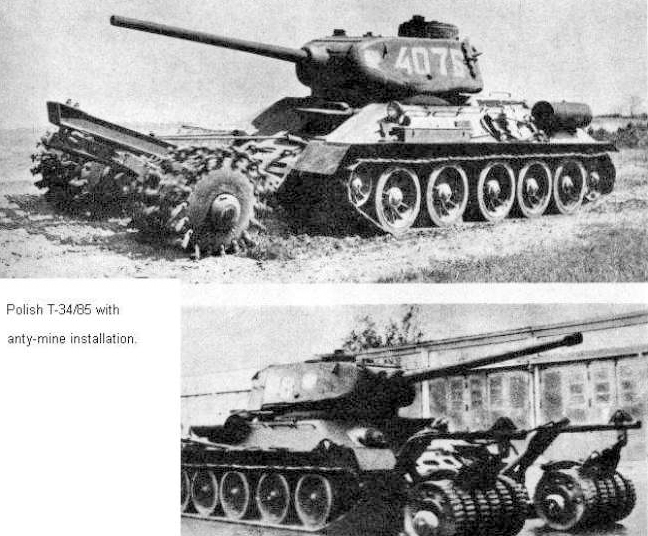
The T-34/85 is a Soviet medium tank that was developed and widely used during World War II and in the years following the war. It was an improved version of the earlier T-34 tank, which had been one of the most successful and influential tank designs of the war. The "T-34" in the name refers to the tank's model, while the "85" denotes the tank's main armament: an 85mm gun. The T-34/85 was introduced in 1944 and featured a larger turret with a more powerful 85mm D-5T gun compared to the earlier 76.2mm gun on the standard T-34.
This larger gun allowed the T-34/85 to engage enemy tanks more effectively. The T-34/85 was known for its simplicity, reliability, and the ability to be produced in large numbers. It had sloped armor that offered good protection, and it was relatively fast and agile for its time. These characteristics made it a formidable tank on the Eastern Front of World War II and in various post-war conflicts. The T-34/85 continued to serve in many armed forces well into the Cold War era, and it played a significant role in conflicts around the world. It remains an iconic symbol of Soviet tank design and World War II history.
Development of the T34/85

The T-34/85 was an evolutionary development of the famous Soviet T-34 medium tank, designed during the Second World War to address the growing threat of new German armored vehicles such as the Panther (PzKpfw V) and Tiger (PzKpfw VI). By 1942–1943, the original T-34/76 with its 76.2 mm gun was no longer sufficient. German tanks were receiving heavier armor and more powerful guns (75 mm KwK 42 on the Panther, 88 mm KwK 36 on the Tiger). Soviet reports from the Battle of Kursk (July 1943) confirmed that the T-34/76 struggled to penetrate these new tanks at normal combat ranges. The Red Army urgently needed an up-gunned and up-armored version of the T-34 that could be fielded in large numbers without disrupting production.
The Soviet design bureaus considered both new tank projects and an upgrade of the T-34. A completely new medium tank, the T-43, was in development but proved too heavy and slow for mass production. The solution was to adapt the T-34 chassis with a larger gun and stronger armor. Key design changes were the new and larger, three-man cast turret with a commander’s cupola (a big improvement over the cramped two-man turret of the T-34/76). The front hull armor increased to 75 mm sloped plate; turret armor up to 75–90 mm. The Main gun was of course the new 85 mm ZiS-S-53 gun (initially prototypes tested the 85 mm D-5T), capable of defeating German armor at typical battle ranges.
Several experimental designs were tested in late 1943: A T-34 mounting the 85 mm D-5T gun. Modified turrets and mantlets tested for effectiveness. After evaluation, the ZiS-S-53 gun was selected for mass production due to better reliability and ease of manufacture. It was officially adopted in January 1944 as the T-34/85. Mass production began in factories such as Factory No. 112 “Krasnoye Sormovo” and Factory No. 183 Ural Tank Plant. Production was kept as streamlined as possible to maintain the Soviet war industry’s output (the Soviets prioritized quantity as well as quality). Between 1944 and 1945, more than 22,000 T-34/85s were built.
It Entered combat in early 1944, first appearing in significant numbers during the Battle of the Dnieper and later in the Soviet offensives of 1944–45. Restored the balance against German Panthers and Tigers, though the T-34/85 was still not invincible. Its 85 mm gun could penetrate a Panther’s side armor and a Tiger’s frontal armor at closer ranges. Remained the backbone of Soviet armored forces through the final offensives into Eastern Europe and Berlin.
Design of the T34/85

The T-34/85 was not an all-new tank, but a deep modernization of the T-34/76. Its design balanced firepower, protection, mobility, and mass producibility, with a focus on simplicity and ruggedness.
Hull and Armor
Hull Construction:
Welded rolled armor plates, maintaining the original T-34 sloped armor design. Front Armor: Increased to 75 mm on the glacis (sloped at ~60°), giving effective thickness >100 mm. Side Armor: 45–75 mm. Rear Armor: 40–45 mm. Turret Armor: Cast or welded, depending on the factory. 75–90 mm thick, with rounded shape to improve deflection. Design Philosophy: Armor sufficient to resist German 50 mm and short 75 mm guns at long range, and to at least have a chance against the Panther’s KwK 42 (75 mm/L70) and Tiger’s 88 mm KwK 36.New Three-Man Turret:
Replaced the cramped two-man turret of the T-34/76. Layout: commander, gunner, and loader (a major improvement — commander could now focus on command, not gunnery). Commander's Cupola: Mounted on the turret roof. Provided all-around vision slits and periscopes, giving far superior situational awareness. Shape: Rounded, larger, with thicker armor.Armament

Main Gun: 85 mm ZiS-S-53 (final production gun, from 1944). Barrel length: L/54.6 (4.65 m). Muzzle velocity: 792 m/s with AP rounds. Penetration: ~100 mm at 500 m (could defeat Panther side armor, Tiger front armor at closer range). Elevation/Depression: +22° / –5°. Ammunition carried: 55–60 rounds (mix of AP, HE, and sub-caliber).
Secondary Armament: 2 x 7.62 mm DT machine guns: Coaxial with main gun. Hull-mounted in ball mount. Ammunition: ~1,890 rounds.
Mobility
Engine: V-2-34 V12 diesel, liquid-cooled. Power: 500 hp at 1,800 rpm. Fuel: Diesel (advantage over gasoline for safety and economy). Transmission: 5-speed manual gearbox. Suspension: Christie-type suspension with large road wheels, no return rollers. Tracks: Wide tracks (500 mm), low ground pressure → excellent off-road mobility in mud/snow. Performance: Max road speed: ~34 km/h. Cross-country: 15–20 km/h. Range: 300 km (internal fuel), extended with external fuel drums.Other specs
Weight: ~32 metric tons. Length: 8.15 m (with gun forward). Width: 3.00 m. Height: 2.7 m. Crew: 5 (commander, gunner, loader, driver, hull machine gunner/radio operator).Optics: TSh-15 telescopic gun sight. Periscopes for all crew positions.
Radio: 9-RS or 10-RK radio set. Unlike early T-34s (where radios were rare), the T-34/85 was universally equipped — crucial for command and coordination.
Other Equipment: Standard Soviet external fuel drums (non-integrated, jettisonable). Onboard tool kits and spare track links mounted on hull.
Production Differences

Factories made small variations:
Factory No. 112 ("Krasnoye Sormovo"): cast turrets with prominent “cheek” bulges.
Factory No. 183 (Ural Tank Plant): more streamlined cast turrets.
Welded turrets were used when casting capacity was limited.
Simplification for mass production: Minimal machining. Standardized parts across production batches.
T-34-85 model 1944 specifications
26’9″ (16’10” without gun) x 9’10” x 8’6″
2x DT 7.62 mm (0.3 in) machineguns
The T34/85 in Action

First Appearance was in early 1944, by entering official service by January 1944, but field tests late 1943. Its First major combat was the Battle of Korsun–Cherkassy Pocket in Ukraine, February 1944. The crews immediately appreciated it stronger gun that could engage German Panthers and Tigers. The better turret design with a commander free from gunnery duties. By spring 1944, whole tank brigades were being re-equipped with it. On the Eastern Front by mid-1944 before Operation Bagration, and until early 1945 the T-34/85 became the mainstay of the Red Army in the final phase of the war.
Against the Panther, its ZiS-S-53 85 mm gun could penetrate the Panther’s side armor at typical ranges (500–1,000 m). Front armor of the Panther (80 mm at 55°) was tough, often requiring flanking attacks or close range. In practice: T-34/85s tried to swarm Panthers, using superior numbers and mobility. Against the Tiger I, its frontal armor (100 mm) could be pierced at ~500–800 m with AP rounds. From the side, it was vulnerable at much longer distances. The T-34/85 was far more mobile than the Tiger, giving it tactical flexibility.
Against the Tiger II (King Tiger), the 85 mm gun struggled badly. Soviet doctrine: use IS-2 heavy tanks and artillery to take them on, while T-34/85s maneuvered around them. The T-34/85 formed the core of Soviet tank corps and mechanized corps from 1944 onward. Operation Bagration (June 1944) saw its first mass-use, helping to destroy German Army Group Centre.
The Vistula–Oder Offensive (January 1945) was a rapid Soviet advance across Poland. It was also widely used in the Battle of Berlin (April–May 1945), spearheading assaults into the city, fighting house-to-house and against German anti-tank weapons. Its main strenght was to have been produced in tens of thousands. It could handle harsh conditions better than German tanks. And in general was an all round "good enough" mix od firepower, armor, mobility balance.
Combat Weaknesses were its vulnerability to German Panzerfausts and Panzerschrecks in close fighting, Inferior optics and fire-control compared to German tanks and main gun less effective against heavy German armor (Tiger II, Jagdpanther).

Postwar Combat Service was intense. It became a Cold War workhorse, soldiering in the Korean War (1950–53) with North Korean T-34/85s initially overwhelming South Korean forces. Once UN forces deployed M26 Pershings and M46 Pattons, the T-34/85 suffered heavy losses. The Chinese also copied it as the Type 58. It wa sorminent still in the Middle East Wars, supplied to Egypt and Syria. It was used in 1948 Arab–Israeli War, 1956 Suez Crisis, and 1967 Six-Day War. By then, badly outclassed by Centurions, M48 Pattons, and Israeli Shermans with 105 mm guns.
North Vietnam used T-34/85s early on, but later replaced them with T-54s. It saw service in Angola, Somalia, Ethiopia, and Yugoslavia’s wars in the 1990s ans still was featured in many conflicts around the globe in militias or reserves. In WW2 it was a war-winner, restoring the Red Army’s ability to fight German armor on more equal terms. Postwar it became one of the most widely used tanks in the world — a symbol of Soviet military aid and influence. Militarily, it also marked the transition between the early war medium tank and the postwar main battle tank (MBT) concept.
Gallery









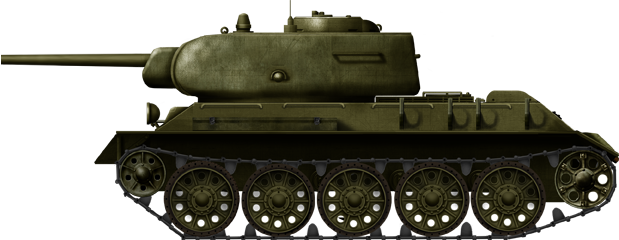
One of the two prototypes of the T-43 designed between December 1942 and March 1943 by the Morozov Design Bureau, and delivered by Uralvagonzavod. These vehicles were up-armoured, had a new three-man turret (adopted later by the T-34-85), a new gearbox, new torsion arm suspension and other improvements. It was still armed with the usual F-34 76 mm (3 in) gun and was slightly slower. Because converting the factory lines for production of this model would be too costly and would add delays to the production, the project was canceled.
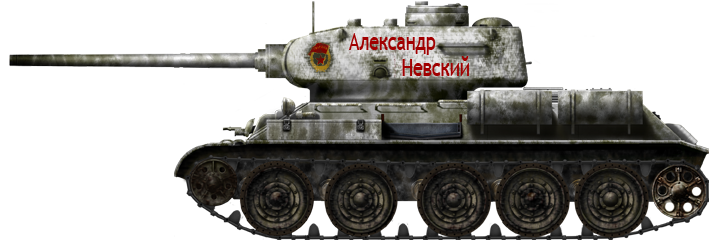
T-34-85 Model 1943, early production vehicle from a Red Guards battalion, Leningrad sector, February 1944.
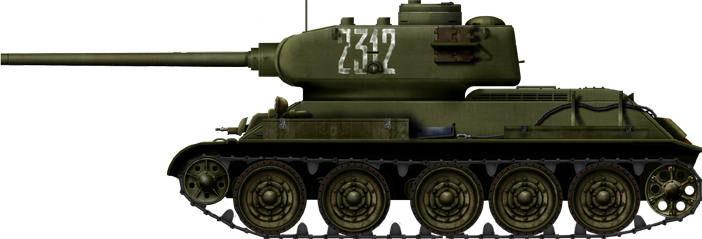
T-34-85 Model 1943, early production version, Operation Bagration, July 1944.
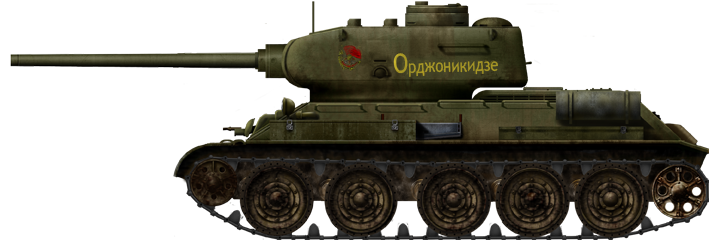
T-34-85 Model 1943, early production version, Red Guards Battalion unit, Operation Bagration, fall 1944.
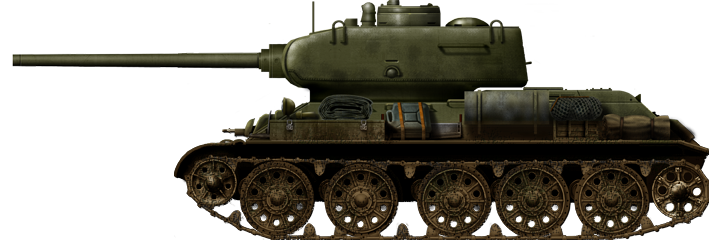
T-34-85 Model 1943, late production, fresh from the Red Sormovo Works at Gorki, March 1944.

A T-34-85 model 1943 from the “Dmitry Donskoi” Battalion. This unit was raised through donations made by the Russian Orthodox Church. This unit was accompanied by several OT-34 flame-thrower versions (based on T-34/76 model 1943). All of these tanks featured white livery and the “Dmitry Donskoy” inscription painted in red, February-March 1944.
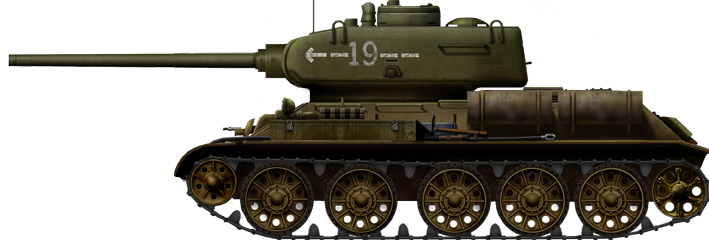
T-34-85 Model 1943 from the 3rd Ukrainian Front, Jassy-Kishinev (Iași-Chișinău) Offensive, August 1944.
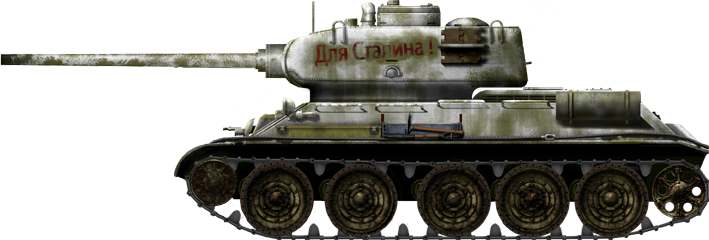
T-34-85 Model 1943, late production version, unknown unit, Southern Front, winter 1944/45.
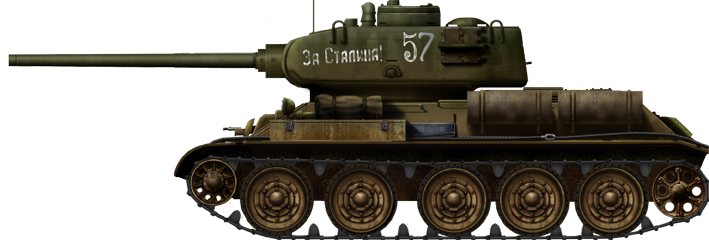
T-34-85 Model 1943, late production version, Third Ukrainian Front, Bulgaria, September 1944.
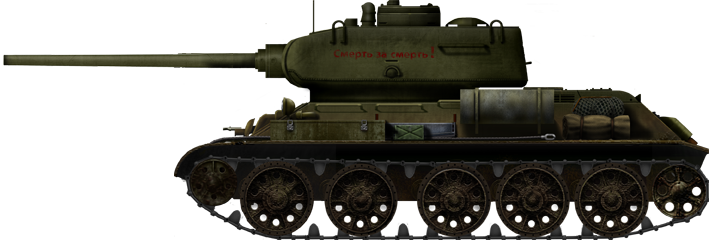
T-34-85 Model 1943 from the First Belorussian Front, Warsaw sector, September 1944.
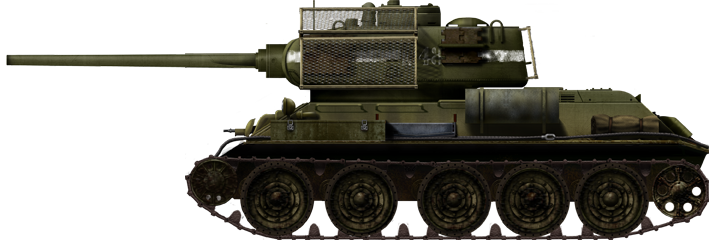
T-34-85 model 1943, May 1945, Battle of Berlin. Notice the improvised protection made of bed frames welded over the turret. They were used to protect against infantry-held Panzerfaust weapons. Others were fixed to the hull sides, although these were partly protected by fuel tanks and storage boxes, and better sloped. The front mud guards were removed. This was often done when fighting in an urban environment and is testified by many photos.
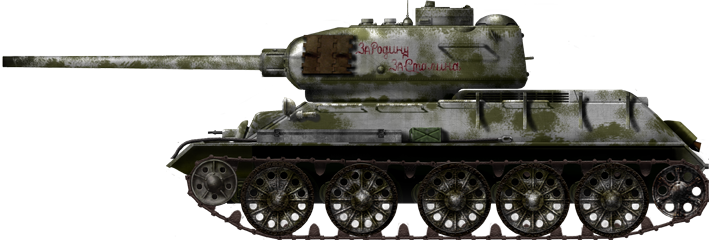
T-34-85 Model 1944 at Dukla pass, Hungary, October 1944.
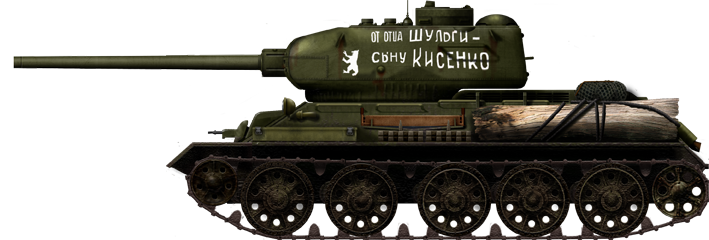
T-34-85 model 1944, 2nd Ukrainian Front, Battle of Debrecen, Hungary, October 1944.
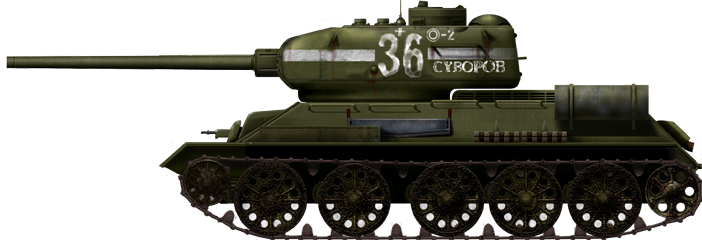
T-34-85 Model 1944 flattened turret model, Eastern Prussia, February 1945.
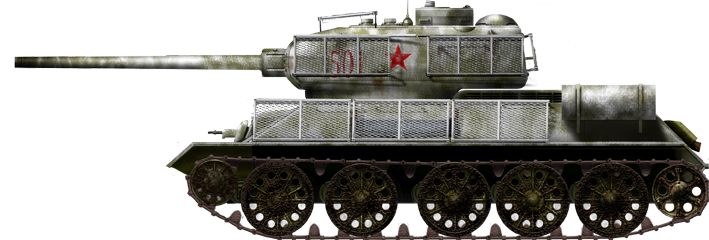
T-34-85 Model 1944 flattened turret model, Budapest Offensive, winter 1944/45.
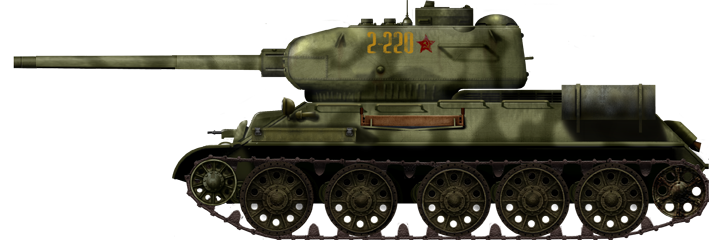
T-34-85 Model 1944 with curved mudguards, unidentified unit, with a rare improvised camouflage.
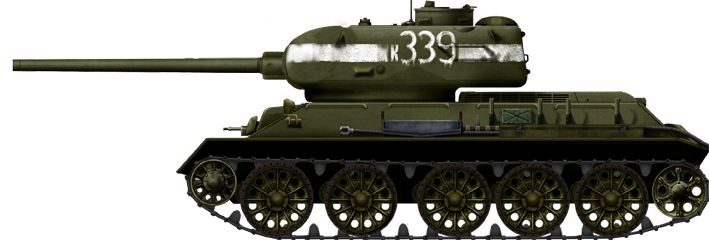
T-34-85 model 1944, with spoked road wheels. The turret had red bands painted on top, intended for identification by friendly pilots. Unknown unit, North-East Berlin sector, April 1945.
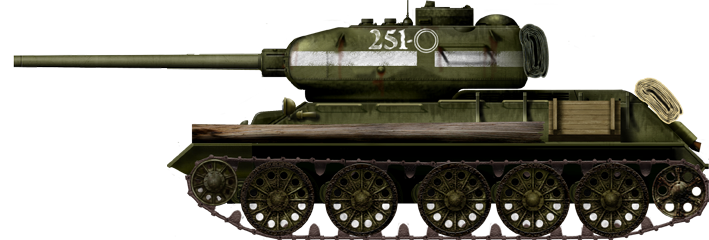
T-34-85 model 1944, sporting improvised wooden protection, Western Prussia, March 1945.
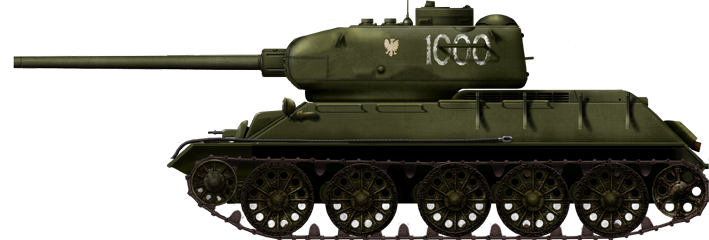
A Polish T-34-85 model 1944, in action in Germany, early 1945. Hundreds of T-34-85’s were part of this new Polish “People’s Army” formed after the liberation of the country in late 1944, sporting the Polish eagle, but driven by Russian crews.
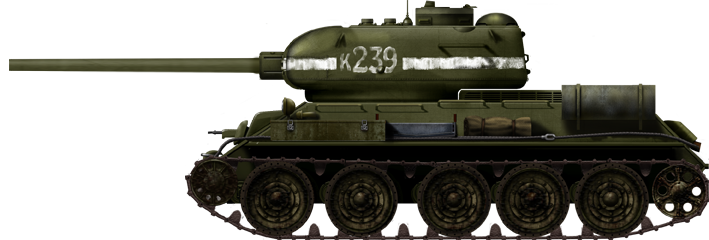
A T-34-85 model 1944 during the offensive on Berlin, March 1944, without mudguards, just before receiving additional protection against the “Faustniks” (Panzerfaust).
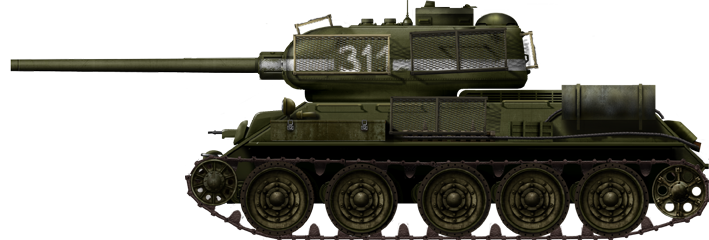
T-34-85 Model 1944, rounded turret model, with additional protection against Panzerfausts, Southern Berlin sector, May 1945.
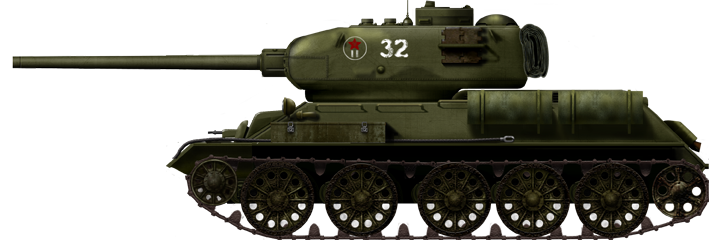
T-34-85 during the Manchurian Campaign, August 1945.
Variants
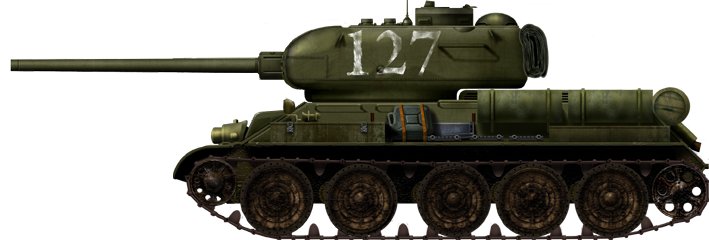
An OT-34-85 of an unidentified unit, 1944. This was the standard flame-thrower variant. The hull machine-gun was replaced by an ATO-42 flame projector, capable of throwing napalm or other flammable liquids to a maximum distance of 100 m (330 ft). They saw extensive use against pillboxes and blockhouses throughout Germany.

SU-100 tank destroyer: An evolution of the SU-85 based on the T-34-85 chassis, developed during the fall of 1944, and rearmed with a longer barreled, 100 mm (3.94 in) version of the D10 antitank gun, to keep pace with the new German tanks. About 2400 were built until 1945.

WW2 Tanks




























WW2 tanks posters

All Tiger tanks liveries.

Panther liveries and variants

WW2 Armour - All tanks











Tanks aces and single tanks series

Find more there

Museums, Movies, Books & Games
The Tanks and Armor in pop culture
Tanks and armored vehicles in general are only really grasped when seen first person: The mass, the scale, it's all there. Explore also the way tanks were covered in the movie industry, in books and in video games.Movies:
Best tanks movie on warhistoryonline.com
On imdb.com
On bestsimilar.com/
miltours.com
liveabout.com/
watchmojo.com
Video Games:
pcgamesn.com
historyhit.com
levvvel.com
vg247.com/best-tank-games
mmobomb.com/
alienwarearena.com

